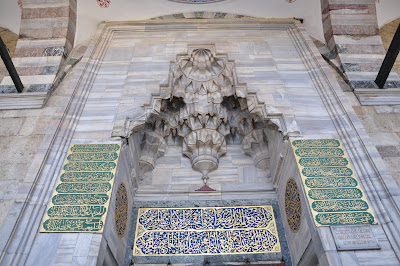 This was the second Masjid that we visited that morning – the Mahmud Pasha Masjid.
This was the second Masjid that we visited that morning – the Mahmud Pasha Masjid.Mahmud Pahsa of Serbia origin was the grand-vizier of Mehmed II between 1453-66 and 1472-74 and is known as a poet and a patron of the arts. Actually, the Masjid is part of the complex built by him inside the city walls following the fall of Constantinople. Other than the Masjid, it consists of a ‘madrasa’ or school, a han, ‘hammam’ or public baths and his mausoleum.
 The Masjid was completed in 1464 (869 A.H.) and thoroughly renovated during the rule of Osman III in 1753 (1169 A.H.) It has since been restored twice, in 1828 and 1936. Unfortunately, there were nobody there during that time and the main door was closed, we did not visit the interior of the Masjid. Nevertheless, through my reading, I have learned that the prayer hall consists of two domed units separated by a grand arch. Its interior of the prayer hall, including the mihrab and minbar, was renovated in the 19th century.
The Masjid was completed in 1464 (869 A.H.) and thoroughly renovated during the rule of Osman III in 1753 (1169 A.H.) It has since been restored twice, in 1828 and 1936. Unfortunately, there were nobody there during that time and the main door was closed, we did not visit the interior of the Masjid. Nevertheless, through my reading, I have learned that the prayer hall consists of two domed units separated by a grand arch. Its interior of the prayer hall, including the mihrab and minbar, was renovated in the 19th century. Ayman looked confused with what he saw! ‘Afi, M Afiq and M Asri were amazed with surrounding and the architecture of the Masjid. The Masjid has a single minaret on the northwest corner, which is accessed from the room to the west of the vestibule.
Ayman looked confused with what he saw! ‘Afi, M Afiq and M Asri were amazed with surrounding and the architecture of the Masjid. The Masjid has a single minaret on the northwest corner, which is accessed from the room to the west of the vestibule. There were few rows of shops inside the complex selling Muslims’ clothing, attire and accessories. We spent around 15 minutes here before we continued our morning adventure at the neighborhood of Sultanahmet.
There were few rows of shops inside the complex selling Muslims’ clothing, attire and accessories. We spent around 15 minutes here before we continued our morning adventure at the neighborhood of Sultanahmet.
0 comments:
Post a Comment